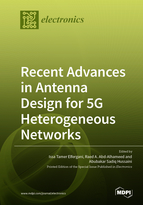Recent Advances in Antenna Design for 5G Heterogeneous Networks
A special issue of Electronics (ISSN 2079-9292). This special issue belongs to the section "Microwave and Wireless Communications".
Deadline for manuscript submissions: closed (31 October 2021) | Viewed by 48672
Special Issue Editors
Interests: reconfigurable/tuneable antennas; MIMO antenna designs for wireless communication systems; UWB antenna with fixed and tuneable notch; beam steering antenna; harmonics rejection antenna techniques; balanced and unbalanced antenna; mm-wave antenna array for 5G; Dielectric Resonators (DR) antennas; high Q RF MEMS bandpass filter design for mobile handset and wireless communication applications; power amplifier designs
Special Issues, Collections and Topics in MDPI journals
Interests: energy-efficient front-end design; radio frequency; energy harvesting; communications systems; 5G communications; sensor design; localisation-based services; signal processing; optimisation process; MIMO system design; health hazards; propagations, antennas and electromagnetic computational techniques
Special Issues, Collections and Topics in MDPI journals
Interests: providing solutions for growing technology and integration challenges from radio frequency front-end perspective including environmentally friendly power amplifiers, RF MEMS filters, wideband antennas, and millimeter wave antenna for 5G applications
Special Issues, Collections and Topics in MDPI journals
Special Issue Information
Dear Colleagues,
5G will support significantly faster mobile broadband speeds, low latency and reliable communications, as well as enabling the full potential of the Internet of Things (IoT). This will open up the possibility for new services such as tactile communications, smart manufacturing and cities, in addition to enhanced broadband connectivity. Pivotal to 5G is the use of the millimeter wave band, which will support a network of small cells enabling hotspot zones of high capacity and area efficiency. The forthcoming 5G system will truly be a mobile multimedia communication platform that constitutes a converged networking arena that not only includes legacy heterogeneous mobile networks, but advanced radio interfaces and the possibility to operate at mm wave frequencies to capitalise on the large swathe of available bandwidth. This will set in place extensive design requirements that even build on the latest 5G roll-out in the sub 6GHz band.
Future emerging handsets and base stations will require antenna technology that is multimode in nature, energy efficient, and above all able to operate on the mm wave band in synergy with legacy 4G and sub-6GHz 5G. Antennas should be compact in nature, but with engineering requirements that include increased power, larger bandwidth, higher gain, and insensitivity to the hand-held effect of human users. This requires very innovative solutions in antenna design, which can operate in single and MIMO/Array configuration.
This Special Issue aims to bring together academic and industrial researchers to identify and discuss technical challenges and new results related to the design of 5G antennas.
Specific Topics
We invite researchers to contribute original research articles as well as review articles that seek to address the issues of antenna design for future emerging heterogeneous 5G applications. Submissions can focus on the research concept or applied research in topics including, but not limited to, the following:
- Antenna design techniques and measurement for 5G systems
- Multiple antennas for advanced 5G transceivers
- Multiband 5G antenna
- 5G Dielectric Resonator antennas
- Antennas on flexible substrates for medical applications
- Wearable and implantable antennas
- RFID antennas
- Antennas for wireless power transmission and harvesting
- Beamforming antenna designs
- Reconfigurable antennas and devices
- Mutual coupling and isolation techniques between antenna elements
- Antennas integration in/on vehicles
- UWB antennas
- Phased array antennas
Submissions should be of high quality for an international journal, and should not be submitted or published elsewhere. However, the extended versions of conference papers that show significant improvement (minimal of over 35%) can be considered for review in this Special Issue. In addition, we welcome review papers covering the subjects of this Special Issue.
Prof. Dr. Issa Tamer Elfergani
Prof. Dr. Raed Abd-Alhameed
Prof. Dr. Abubakar Sadiq Hussaini
Guest Editors
Manuscript Submission Information
Manuscripts should be submitted online at www.mdpi.com by registering and logging in to this website. Once you are registered, click here to go to the submission form. Manuscripts can be submitted until the deadline. All submissions that pass pre-check are peer-reviewed. Accepted papers will be published continuously in the journal (as soon as accepted) and will be listed together on the special issue website. Research articles, review articles as well as short communications are invited. For planned papers, a title and short abstract (about 100 words) can be sent to the Editorial Office for announcement on this website.
Submitted manuscripts should not have been published previously, nor be under consideration for publication elsewhere (except conference proceedings papers). All manuscripts are thoroughly refereed through a single-blind peer-review process. A guide for authors and other relevant information for submission of manuscripts is available on the Instructions for Authors page. Electronics is an international peer-reviewed open access semimonthly journal published by MDPI.
Please visit the Instructions for Authors page before submitting a manuscript. The Article Processing Charge (APC) for publication in this open access journal is 2400 CHF (Swiss Francs). Submitted papers should be well formatted and use good English. Authors may use MDPI's English editing service prior to publication or during author revisions.
Keywords
- 5G system
- MIMO
- Array antenna
- Mmwave
- Flexible Substrates
- Wearables
- Energy Efficient
- Compact Antenna
- RF MEMS
- Reconfigurablity








